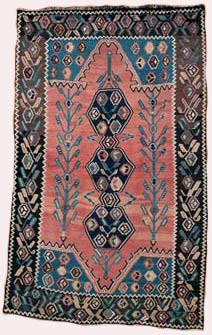Weaving is one of the major achievements of mankind. In the ancient world, especially in those parts of Asia where people were engaged in animal husbandry (particularly of sheeps), the textile industry and weaving and carpet making were widely developed.
Pileless carpet weaving is centuries old, the same as carpet weaving, but it has a longer history.The raw materials for carpet were sheepand camel wool, soft goat hair, cotton and silk. In Vaspurakan, for example, people used the hair of goat called “chur,” as well as wool,hemp, flax, cotton, and silk thread.
People used various types of pileless carpets. These include, for example, mezars, which were used to cover the lavash bread and doughballs, and were woven like canvas. They were initially created as a woven mat. According to Serik Davtyan, it was a transition from weaving to pileless carpet weaving. Narrow and wide strips were juxtaposed to form the mezars, arranged from top to bottom. Mezars were also unique due to the fact that their main threads were colored. Their production was mainly distributed in all regions of Armenia ,especially Dilijan, Artsakh, etc.
The jejim (jim-jim) served as bedding; it sewed the surface of the mattress. The technique for jejim sewing was almost the same as that for mezars. They were also plain, but decorated at times. The patterns were created with separate threading by sticks. Those sticks helped keep the number of weaving patterns. The patterns of jejims were usually expressive. They were used for dowries.
Two-way (“matnakash” – finger-made) pileless carpets were used in everyday life. The main thread of such carpets was monochrome, sometimes with flaky or repetitive patterns. The carpet has the same decorations on both sides; they are large, colorful, and clear. They basically have a center contoured by belts, they are close to rugs in their composition, and carry the most ancient types and ideas of ornament patterns.
The most distinctive ones among them are large medallions, cruciform patterns, various bird,animal- and plant-typepattern forms. Unlike mezars and jejims, cotton and silk threads are used in double-sided carpets.
The usage of double-sided carpets is wide: on the floor, under the bed, or on the wall. The pileless carpets were used as shrouds for thedeceased; there were also prayer carpets.
The pileless carpets of Artsakh, as well as those of Siunik and Lori, are particularly beautiful. The pileless carpets of Van-Vaspurakan, Khoy-Salmast, Kilikia, Malatia, Great Aik are also unique.
Large rugs were widespread in Artsakh, and were woven together with family carpets, rug runners, and sleeping-bags, as part of dowries.It is noteworthy that they have sizes that are typical for classic vishapagorgs (dragon-carpets): two meters in width and eight meters inlength. The meghvakarpets (bee-carpets) and the pileless carpets called “Krkeni” are typical in the carpet weaving centers of Artsakh andSiunik. Their patterns are also used in rugs. Patterns typical for arevagorgs (sun-carpets) were also used in pileless carpets. The pileless carpets called teltogh (thread-left) are also characteristic of the abovementioned regions.
Interesting pileless carpets have been created in current-day Lori and Tavush. They are characterized not only by geometric compositions, but also by plants and animals, as well as bird images. Carpets and rugs with images of deers and peacocks, as well as with almond-ornaments, were widespread. The image of the tree of life is most popular among compositions with geometric design. Female figures are rarely seen.
The pileless carpets of Western Armenia are very different by their composition and color scheme. They have detailed geometric designand relatively dark coloring. The pileless carpets of Khoy-Salmast and Jugha also have a detailed pattern design.
Thus, pileless carpets were used in Armenian life during the nineteenth and twentieth centuries, as well as before, in different ways. Perhaps that is the reason for having so many different types of them today. Each rug expresses the specificity of the place of its creation, history, and lifestyle.











Leave a Reply